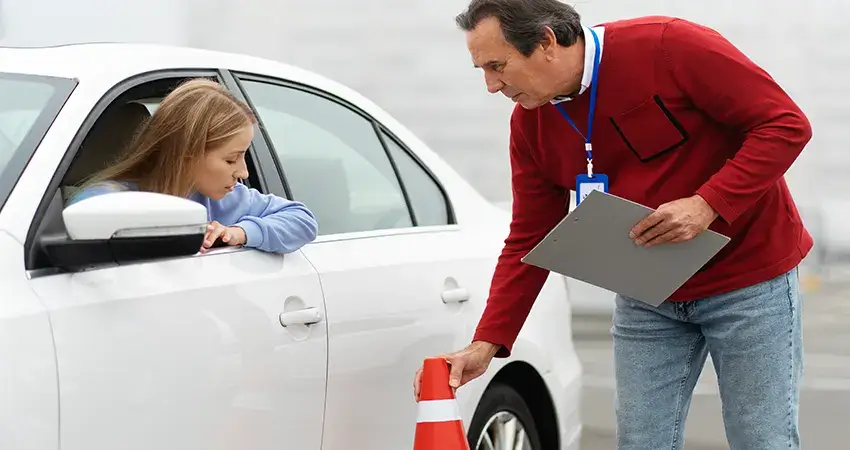To drive safely, it takes much more than passing your driving test. You need to be aware of your environment, predict the risk you are exposed to, and stay calm. Driving is a daily responsibility that requires you to think quickly, use good judgment, and consider all road users, regardless of whether you are a beginner or an experienced driver.
To drive skilfully means much more than knowing how to operate a vehicle; it requires driving knowledge, skill, and intention. In this blog, we will share 10 tips and techniques for defensive driving in the UK, which can help you be safer, reduce your stress, and make better decisions. These skills are also fundamental for becoming more confident behind the wheel and for contributing to safer roads around the UK.
What is Defensive Driving?
Defensive driving is more than just obeying the rules or passing your exam. It is an international approach to engaging with and responding to a road environment. Rather than reacting to hazards as they occur, defensive drivers proactively search the environment around them, anticipate potential risks, and drive accordingly. Regardless of factors such as limited visibility, unexpected behaviours by other road users, or other unpredictably hazardous conditions, the goal is always to be one step ahead of hazards. Engaging in this type of driving reduces risk, allows for smoother traffic flow, and enhances your preparedness for responding to events and stimuli in the environment surrounding your vehicle.
At MA Driving School, we believe that defensive driving is more than simply a skill or a tangible thing; it is a mindset that every responsible driver should embody and carry with them. Not only are you thinking about your movements, but you are also anticipating what other drivers may do, and you are making careful and considered decisions in all driving situations.
Defensive drivers are always prepared for the unexpected: they maintain safe distances, minimise distractions, and adjust to the changes in road, traffic, and weather conditions. Being mindful of road warning signs in the UK is also an essential aspect of defensive driving, as they provide valuable information about hazards in advance. When drivers can recognise and act upon relevant warning signs correctly, they can avoid an emergency much before it arises. It makes driving much safer and controlled.
Importance of Defensive Driving
The significance of defensive driving cannot be overstated, especially given the busy and unpredictable nature of UK roads today. In the UK, thousands of accidents occur every year, often due to poor judgment, distraction, speeding, or simply disregarding road laws. Many of these collisions could be eliminated by merely understanding more about road safety and being aware of the driver’s actions.
Defensive driving has a significant impact on the math of accident prevention by instilling alertness, caution, and consideration. By anticipating threats and maintaining control in challenging driving situations, you reduce the likelihood of being involved in a serious incident. Being knowledgeable and applying the underlying principles of traffic laws demonstrates a measure of responsibility not only in furthering your safety on the roads but also in allowing other road users to stay safe.
Many insurance companies offer additional benefits, such as discounts or free coverage, to drivers with a clean record. Therefore, defensive driving is not only a safety benefit but also an economic gain-changer from both perspectives. Above all, it is a commitment to safer roads and a better driving culture.
Benefits of Defensive Driving
Here are some of the significant benefits of defensive driving that all UK drivers should know about:
- Fewer Accidents: Defensive drivers are often much more aware and prepared, and for this reason, the likelihood of being involved in collisions is significantly reduced.
- Reduced Insurance Costs: Most insurance companies offer discounts to drivers with a clean driving record and a no-claims bonus.
- Improved Reaction Time: When you see potential hazards ahead of time, you can react much faster and more safely than you would typically in an emergency.
- Increased Driver Confidence: Drivers will feel calmer and reassured that they have control and are aware of their surroundings, even in very challenging circumstances.
- Better Awareness of Road Management: Defensive driving will increase your awareness of how (and often what you don’t do) your activity has on other road users and increase your courtesy and predictability when using the road.
- Better Compliance with Road Laws: Safer practices usually mean fewer fines, fewer penalty points, or other legal consequences, as you are more likely to follow the rules and regulations.
Defensive Driving Techniques
Here are ten fundamental tips and techniques every driver should learn to remain safe and drive smart. Each piece of advice goes beyond the fundamentals and encourages proactivity to notice dangers developing before they become a problem. Knowing and mastering these strategies can improve your confidence on the road and lower the risk.
Maintain a Safe Distance
Maintaining a safe distance between your car and the one in front of you is one of the easiest and most effective ways to avoid collisions. In the UK, there is a general rule regarding the distance between your car and the vehicle in front of you, known as the 3-second rule. Ensure your car is at least 3 seconds behind the vehicle in front of you for cars travelling in good weather, but more if the weather is bad or the road is slippery.
The additional space provides sufficient braking distance when the vehicle in front stops suddenly. Additionally, it reduces the likelihood of being a tailgater, which can increase the potential for an accident and increase the stress level of other drivers on the road. It is also essential to comprehend vehicle stopping distance at different speeds to maintain control and defensive driving.
Look ahead
Defensive drivers scan the road ahead and pay more attention to “what’s ahead” instead of just watching the back of the car in front of them. Anticipating the flow of traffic allows them to slow down and move to a better position early on, giving them time to react safely and avoid potential hazards.
Utilising good scanning techniques and maintaining a clear line of sight will help you detect hazards such as vehicles with low momentum, curves in the road, or pedestrians near crossings. Good visual search patterns will enable you to detect dangers and make more intelligent decisions when driving.
Don’t Overspeed
Understanding the risks associated with speeding is a foundational concept of defensive driving. Driving over the speed limit reduces your reaction time, increases the severity of accidents, and unnecessarily places you and others at risk.
Being aware of the speed limit is essential; always follow posted speed limits, and reduce your speed in adverse weather conditions and areas with schools and residences. As a side note, speed cameras are not just there to catch speeders; they are there to save lives by encouraging safe driving behaviour.
Take it Slow in Rain or Snow.
Driving in adverse weather conditions can be more demanding in terms of time and concentration, especially during torrential downpours or snow. Flooding can decrease traction on the road, and if the roads are wet or icy, the distance for braking and safe vehicle control is drastically reduced.
Read these rain and snow driving tips: reduce your speed, increase your following distance, and avoid rapid, sudden movements. Watch for hydroplaning (when tyres lose contact with the road) and ensure your vehicle’s ABS is working if you’re driving one equipped with this feature. In bad weather, limited visibility is also a concern. Please remember to use dipped headlights and keep your windscreen cleared of rain and/or snow.
Signal Intentions Clearly
The common practice of using your turn signals is one of the most neglected aspects of safe driving. Signalling properly enables you to communicate while driving, giving others time to react to your decisions and reducing the risk of confusion or hitting something or someone.
When making a turn, lane change, entering or exiting a roundabout, or stopping your vehicle, you should always use the indicator lights. Always use your brake lights; signalling your brake light promptly allows the driver(s) behind you to see that you are either slowing down or coming to a stop. Besides good signalling habits, you should also be aware of the signs and markings that will prompt any decision you make. For a full breakdown of all the signs, markings, or essential indicators, be sure to check out our post: UK Guide Signs: A Complete Learning Guide for UK Drivers – it should be a compulsory read for every driver.
Mirror, Signal, Manoenure (MSM)
The MSM stands for Mirror, Signal, Manoeuvre. It helps you perform every driving action carefully while staying aware of your surroundings.
Before moving off from a parked position, changing lanes, or overtaking, it is essential to check your side mirrors and complete a blind spot check. When it is done safely, you can signal your intention clearly, then position yourself safely and confidently on the lane or overtake another vehicle as needed. Following the MSM routine allows you to avoid abrupt movements and helps keep traffic flowing safely.
Prepare, Observe, Move (POM)
The POM stands for Prepare, Observe, Move. It’s essential for safe driving, especially when starting from a stop. Following this sequence helps you avoid hesitation or jerky starts while keeping full control of the car.
Start by preparing your car for the move, ensuring it is appropriately set up. This involves finding the bite point with clutch control and releasing the handbrake smoothly. Then make a complete observation before moving, which means checking your mirrors and blind spots to ensure it is safe to move off. If you feel secure, then move off gently. These car control operations form the foundation of controlled and smooth driving, whether moving off at a junction, manoeuvring around a parked roadside vehicle, or stop-start driving.
Mirror, Signal, Position, Speed, and Look (MSPSL)
The MSPSL stands for Mirror, Signal, Position, Speed and Look. It’s an advanced driving routine that builds on MSM and is especially useful at junctions, roundabouts, or when the road layout changes. It helps you stay fully aware, prepared, and careful for any manoeuvre, making it important for driving tests.
Begin by checking your mirrors, your surroundings, and signalling clearly. Then, position your vehicle correctly according to your intended course of action, observe and control your speed, and check the road ahead for any traffic signals or other potential hazards. Using this routine helps us remain in control and keep vigilant to stay safe, and can be helpful in busy or complex driving situations.
Understand the Hierarchy of Road
A significant aspect of defensive driving is understanding the hierarchy of road users, which acknowledges the risk that mortality poses to road users, with the most vulnerable road users positioned at the highest level in this hierarchy. The recent changes to the highway code also clarify this principle more clearly in terms of road priority, assigning greater responsibility to the driver for the safety of others.
Regarding the updated road priority rules, you must give pedestrians the right of way first at junctions and crossings, then to cyclists, horse riders, and finally to motorcyclists. Having an understanding of who has priority will not only help prevent accidents from occurring but will also help with the shared road space that we are all entitled to. For all conscientious drivers, keeping updated with these changes is crucial.
Know the Vehicle’s Blind Spot
Knowing your vehicle’s defined blind areas is crucial for driving safely, particularly when driving on roads with multiple lanes or on motorways. Blind spots are areas around your car that you cannot see in your rearview or side mirrors, making awareness of these areas a critical skill to develop.
To minimise risk, ensure that you adjust your mirrors appropriately before departing and always perform an over-the-shoulder check before changing lanes or merging. This practice can significantly enhance your chances of successful lane changes and help you avoid collisions with other vehicles, bicycles, or pedestrians that may be obscured from view.
Take Your Driving to the Next Level with MA Driving School
Are you ready to put these defensive driving strategies into action? At MA Driving School, we have developed a comprehensive defensive driving course designed to enhance your driving skills, boost your confidence, and keep you safe on today’s roads. Whether you’re preparing for your road test, obtaining driver certification, or simply looking to improve your driving skills, our professional staff will be happy to assist you.
Join a traffic safety program today and begin your journey to be a responsible road user. Defensive driving is not a skill — it’s a habit for life, starting with the training. Book your course now and see why MA Driving School is the right choice for you.




